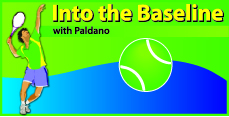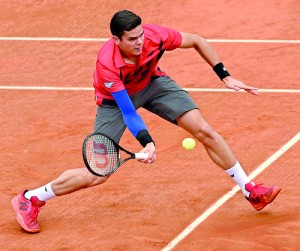Hard-Court and extreme athletes
View(s):Clay and grass surfaces reward variation of ‘skills’. It is not so on Hard-Courts. Hard-Court Tennis is very physical. The physical attributes of five ‘S’s; strength, stamina, speed, suppleness and stability forms the core, to win on hard-courts. This means it pays if the player is tall, well built and athletic. The country that took to hard courts ‘gung-ho’ is USA. Hard courts were considered to be the symbol of modern Tennis development in the 80s. At about the same time US players began to dominate the world of Tennis.Americans’ Arthur Ashe, Jimmy Connors and their mates had the world in their palms in that era. Their domination made Hard-Court-wave to sweep the world and the Hard-Courts appeared in every corner of the globe.
Some years back the US Open was played in Forest Hills and the surface was grass. The present venue, Flushing Meadows in New York has Hard-Courts. Switching from Grass to Hard-Courts, in all probability, was the right thing to do. USA hardly had any Grass courts. Then, how could USA play their national championships on a surface not available to most Americans? Today two of the Grand-Slams Australian-Open and US-Open are played on hard courts. They are the first and the last grand-Slams in the Annual Tennis calendar.
Changes in the game
A tournament court is placed in a 60X120 feet area. It is considered the standard space needed for competition. Because of the low bounce grass court game keeps the players very close to the base line, side lines and within the court, which is only around 36 x 72 feet in dimensions. Clay uses more of the perimeter than grass and gives the most time to hit a shot. Hard court bounce will send players to the full extent of the court’s perimeter and does not give much time either because the ball does not lose speed on Hard Courts. This is why most players are often seen closer to the linesmen behind the base line than the net on Hard-Court. Some players reach the net from deep down the court for a drop shot with relative ease. This is the extreme athlete-ship that makes a player win on Hard courts. Rafael Nadal of Spain exhibits this skill with amazing ease and lethal results.

Milos Raonic (pictured above) beat his fellow Canadian Vasek Pospisil to win the last hard court event in Washington DC.
In recent times Tactics of the game on hard court is changing to more of a variety and that is pleasing to watch. The change is coming from the emerging athletic ability of players. Milos Raonic beat his fellow Canadian Vasek Pospisil to win the last hard court event in Washington DC. At match point, Raonic played a sizzling passing shot from a point very close to the first row of spectator on the backhand side. First question that came to my mind was not how he played the shot but ‘how’ on earth did he reach it? Such was Raonic’s athletic ability and anticipation. There is no safe space to send the ball on hard courts. Then what are the tactics on Hard?
Game compilation and Targets
In every Tennis match it is obvious someone wins. So, how to survive and prosper on Hard-Court? If a player does not get enough time, going for ‘narrow target’ with speed and precision will be a big gamble and sure to mount the unforced error rate. However, with speed it is safe to use ‘wide targets’ as the general rule but this will take away ‘surprise’ and ‘effective’ elements of tactics from base line. Wide target even with speed does not put the good opponents into trouble. It can only be used to sustain the rally.
This is certainly not convenient. So every player has to sort a way out of this riddle when using speed and wide target tactics. Many inexperienced players have no answer to this riddle and end up having very long rallies. There is another way to give the opponent less time. That is going to the net behind a wide target shot with speed; it works well and is good enough to compile a game and have it registered in the score card. Simply said, a player need not win every rally to win a match but compile the game tactically. On hard courts, using wide targets to win is ‘Tennis made easy’ if the art of game compilation is mastered.
Hard court and contemporary competition
The first step in Hard court Tennis, which really has not reached 50 years yet, is to understand the ‘challenge’ it offers in a match. In the tactical approach of the game ‘self’ comes first then the ‘court’ and finally the ‘opponent’. This line of priority is the deciding factor of contemporary winning Tennis. All three changes whenever any one of them changes. This forms the basis of the Game-making-ability and it is the most vital aspect in contemporary competitions. Understanding Hard-Court competition is critical to go up in any rankings today.
On Hard-Courts, control over the game cannot be achieved without the five physical abilities. It is proving to be tricky. Often players develop physical muscle mass and mess up reaction speed, suppleness, endurance and the range of movements. It is a critical area of development and takes a few years to cultivate. Roger Federer, Pete Sampras among men and Martina Navratilova, Steffi Graf, Justine Hennin and Martina Hingis are good examples of the balanced physical development. In Doubles, the Brian Brothers are outstanding in this aspect. It is often quoted that, doing other sports, that is cross training, provides the balance in physical needs better than isolated programmes. It is also an interesting method and also develops effective competition mind-set.
Canadians have arrived
If there is a study in Tennis for physical strain, break down and injuries, Hard-Courts would get the first blame. The surface has the worst shock absorbing ‘give-in’ of all known surfaces on which Tennis is played. So I am not sure if the Hard-Court popularity will see the 100-year mark. Meanwhile, it has provided the base to play Tennis even in cold Canada. 2014 saw most Canadians appearing in Grand slams and ATP tours. I will not be wrong to say Hard-Court made Canada into a Tennis country. Only thing is that, one has to be 6 foot and 5 inches tall, like Milos Raonic – currently ranked 6th in the rankings, strong as Eugenie Bouchard who reached the Wimbledon finals or nimble footed as Vasek Pospisil who won the Wimbledon Doubles. At the end of this month it is the US-Open on Hard Courts and the Canadians are ready!
* George Paldano, former international player; Accredited Coach of Germany, ITF and USPTR; National, Davis Cup and Federation Cup Coach–gptennis.ceylon@gmail.com-


